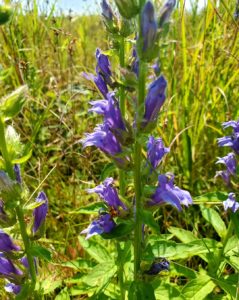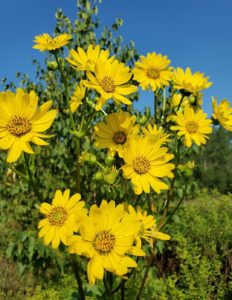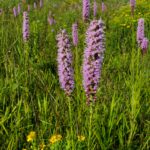
Recently I have been out walking through our prairies at Woodland Dunes to identify and plot what plants are blooming where. Which to be totally honest, feels a bit too fun to actually be work. If you have been out near the prairies recently (hopefully with some bug spray) you will know what I mean. Even though it is late in the summer and some of the wildflowers are done blooming, there are still hundreds (literally, I have a list) of flowers of all sorts of sizes and colors on full display.
Walking through these prairies and seeing not only the beautiful flowers, but also the pollinators and birds that rely on these late blooming flowers is such a wonderful experience. Some creatures time their life stages based off of the late blooming flowers. For example, American Goldfinches nest late summer because they use mature thistle down (which blooms at the end of summer) to line their nests.
Bumblebees buzzed around almost every plant that I passed, beetles crawled along the leaves, butterflies floated overhead, songbirds were chirping in the trees that are now full of berries, and of course the occasional catbird interrupted the peaceful setting with a loud scream from above.
Willow trail and Coneflower trail are perfect for visitors to see the beautiful prairie plants, pollinators, and birds. It really is a wonderful time to come out and experience all sorts of colorful wildflowers before it gets to be too late in the season. Just remember to bring your bug spray! To try and paint you all a picture of a few of the plants that we have out here and how colorful the prairies are, I have made a list of some of my favorites from all of the colors of the rainbow (with a few extra colors too).
Red: Pale Purple Coneflower (Echinacea pallida) has beautiful drooping purple leaves with a bright red cone in the center. They are a Wisconsin threatened species, and we are lucky enough to have them in almost all of our prairies here at the Dunes.
Orange: Butterfly Milkweed (Asclepias tuberosa) has a bright orange color that matches the monarchs that love them. Every time I pass by one of these plants I see butterflies nearby.

Yellow: The Cup Plant (Silphium perfoliatum) is my favorite plant so I had to include it in this list. Besides the very strong bias for this plant, it is a really neat prairie plant to have around. Towering above the other prairie plants, this giant plant with yellow flowers that pollinators of all kinds love also has huge leaves that collect water that birds and insects drink out of. How cool is that?
Green: Spotted Horsemint (Monarda punctata) has way more colors than just the green of its leaves. This is one of the cutest plants that I saw out in the prairies. With tubular shaped yellow flowers with purple spots above rossettes of either white or pink tipped bracts (which are modified leaves) this mint plant is sure to leave you wondering if it was real or just a fig-mint of your imagination.
Blue: Great Blue Lobelia (Lobelia siphilitica) stands up to three feet tall with bright blue flowers. (Also called blue cardinal flower) this late blooming plant is not only gorgeous but also attracts hummingbirds too!

Purple: Blazing Stars (Genus: Liatris) are tall perennials that have electric purple flowers. This plant attracts bees, butterflies, and birds! Our prairies are full of a few different species of blazing star including prairie blazing star and rough blazing star.
Pink: Flodman’s Thistle (Cirsium flodmanii) is currently growing in a prairie plot that I have planted with some of Wisconsin’s endangered, threatened, and special concern species. This spiky plant has rosy colored flower heads and similarly to other native thistles the Flodman’s Thistle has less dense and prickly spines unlike the nonnative ones. And remember, some species (like the American Goldfinch) rely on native thistles, so not all thistles are bad.
Black/Brown: Black-eyed Susan (Rudbeckia hirta) is also blanketing our prairies with bright yellow flowers with a black or brown center. The bright yellow flowers attract all sorts of pollinators to our prairies.
White: Rattlesnake Master (Eryngium yuccifolium) is a plant I literally stumbled into, and boy what a surprise that was! This plant towers over a lot of the other prairie plants, with spiky leaves, and golf-ball sized white flowerheads. Even though it looks similar to thistles, it is actually a member of the carrot family.
Now that you know how colorful our prairies are, I hope that you can come on out here to see the flowers for yourself. Because not only will you get to see gorgeous flowers all around you, if you look closely you can see the many different pollinators and other wildlife that rely on these native wildflowers to survive.
